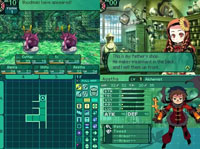Etrian Oyssey II: Heroes of Lagaard
Nintendo DS
Reviewed: 06/26/2009
 On the Northern Continent lies the Grand Duchy of Lagaard, where a crisis is brewing. The specifics of this crisis are rather chilling when compared to the texts of the past, which tell tales of the entire continent sinking, save for a solitary floating castle. That castle has been lost to antiquity, but it may hold the secret to overcome the ill shadow that has been cast over the land. Many brave adventurers have come together under the banner of guilds to unlock this mystery… guilds like yours. So begins Etrian Odyssey II: Heroes of Lagaard.
On the Northern Continent lies the Grand Duchy of Lagaard, where a crisis is brewing. The specifics of this crisis are rather chilling when compared to the texts of the past, which tell tales of the entire continent sinking, save for a solitary floating castle. That castle has been lost to antiquity, but it may hold the secret to overcome the ill shadow that has been cast over the land. Many brave adventurers have come together under the banner of guilds to unlock this mystery… guilds like yours. So begins Etrian Odyssey II: Heroes of Lagaard.
The player finds himself in charge of a guild, which may or may not be brought over from the first game depending on if the player can get the god-awful password system to work. From there, they are given access to a dozen classes, and one, which must be unlocked. The players are encouraged to make a well-balanced team of five, and then sent out on the very first mission of the game, where they will most likely die. I’m not exaggerating here. This game’s level designers thought it would be simply hilarious to have the first mission put all the characters in the middle of the first floor and not let them out until the player has mapped the first portion of it. I, a seasoned player of the first game, survived this mission with only one character of five still standing!
 |
This game is truly the perfect sequel. For players unfamiliar with the first, it’s a game that combined dungeon crawling, party management, and cartography. You see children, back in the old days of computer RPG gaming, there were no built-in maps for games, this would take up to much precious memory. So players had to trek 5 miles, uphill both ways, in ten feet of snow to the store just so they could get graph paper to map out what was where. They usually did this with their own sweat and blood, because in the 1980’s, role playing was all about the occult and annoying Jack Chick. Fortunately, this game makes the cartography aspect much easier to manage via the use of the touch screen and the stylus. There are many more icons and shading tools to map with than the first game gave. Whereas the first game had me editing my maps because I had placed too many icons and notations on the earlier floors to add more on the later ones, this game had no problem allowing me to clutter up my maps with notes and other miscellanea.
The dungeons and the nefarious FOEs, more monsters on a floor that move in time with the player’s movements, are much more challenging in this version. From layouts that take advantage of specific class abilities, to FOEs that are after their daily dose of unprepared adventurer, the game consistently has a new challenge to throw at players. Through this, light narrative is given to explain the threat of Lagaard, in a manner that gives the dungeon feeling and backstory without ever really taking over what’s really important, the dungeon itself. Players will consistently be asked to change their party set-up and try new solutions, both to taking down monsters and overcoming specific floors. At times, this creates a bit of tedium as new characters must be both leveled and equipped. But it’s much more preferable to the first game’s approach to “create a party and run to the end.” The grind of the game is also made easier by the inclusion of an auto-battle function that isn’t smart by any means but saves the player from hitting buttons during easier battles.
 |
The music is absolutely beautiful. Yuzo Koshiro does a wondrous job of fitting this dungeon with background and battle music that works, and works well. Each series of floors has it’s own tune and the battle music varies at intervals which keep things from getting stale. The graphics are upgraded as well, with vibrant dungeons and a lot more original enemies with less color swapping than the first game. There is some recycled artwork, sure, but it is easily overlooked.
The musical score and the graphics are not what will make players decide if they will love this game or leave it. Ultimately, the player’s ability to discover the secrets of the Labyrinth of Lagaard and its floating castle will only be decided by how they feel about grind-fests and unforgiving challenges. For gamers who fondly remember the days of yore when the only story one needed in a game was the hook “Your party meets at a tavern,” this game delivers a truly wondrous dungeon crawl. For players expecting a story to be told and characters to identify with, not even this game’s musical score will save the player from the unholy amount of tedium and pain they will face. The chance to overcome this game’s dungeon is the only reward Etrian Odyssey II offers, so players should judge their tastes before making a purchase.
-Timothy Olsen
| Score Breakdown | ||
| Overall Great Out of 10 See our Review Criteria |
Gameplay | Very Good |
| Story | Below Average | |
| Graphics | Good | |
| Sound/Music | Great | |
| Replay Value | Great | |
| The Verdict: Eight | ||








